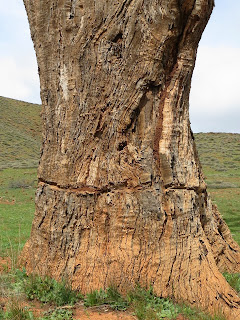copy+-+Copy.jpg) |
| A slightly demonic-eyed Gibberbird (you've got to impressed by these guys, living the hard life on the gibber plains of Central Australia--you'd have hard eyes, too!) |
 |
| range map for Gibberbirds |
This is a gibber plain - hardly what we would have thought was "good habitat!
Gibber 'pavement". Although this is all pebbles with mud/dust cemeting them, it is not very hard. Its a bit spongy to walk on and would be a slow-go to drive, and destructive, as well--compressing it down would be de-stabilizing.
We were thrilled to spot a few Inland Dotterels at dusk as we eked all the birding we could out of the waning light as we drove towards Muloorina Station where we planned to camp.
Inland Dotterels have mastered the art of camouflage. With their back to us, their mottled feathers blend into the multi-hued gravel. Facing us, the stripes on their breast appear to be the dark sticks of a small bush. Interestingly, we found out that they eat seed and leaves during the day, and switch to eating bugs at night--they are mostly nocturnal, presumably to escape the heat.

Much of the land (almost all) along the Birdsville and Strzelecki Tracks belongs to cattle stations (i.e. 'ranches), in part because the tracks were established to move cattle! Camp at Muloorina is at a man-made wetland/lake that has become a haven for birds. Explorers found they could bore (drill) into the Great Artesian Basin (which underlies parts of Queensland, New South Wales, South Australia, and Northern Territory) and it became a reliable water supply, enabling the establishment of cattle stations in the interior of Australia.

We arrived in the dark and had a great camp under a full moon. We could see ducks paddling around in the lake, spreading sparkles of moonlight.
There was only one other camper in this lovely spot. The owners of Muloorina station kindly provided the opportunity for us to stay there, even providing an outhouse and fire rings for us. Our payment for the camping at the 'honesty box' went towards the 'Flying Doctor Service'--opportunities for medical attention are few and far between out here, so this is an important community service.
 |
| Canoodling Galahs |
Galahs became a constant - anywhere there was water they were present in large numbers. Always pretty is the first and last light.....
 |
| Black-tailed Native-Hens |
 |
| Pink-eared Duck |
Early morning birding revealed this party of native-hens. Wonder what a male Native-hen is called?!
We (re)learned a critical birding lesson - always check your ducks! We saw a lot of coots, Pacific Black ducks and Hardheads - all fairly common. But then - - what is that? It's a pair of Pink-eared ducks hiding out among the more common fowl! They are rare (though as we were to find, they can be locally common) and due to a skittish nature, Dirk spent considerable time trying to get a decent picture
 |
| Two Pink-eared Ducks |
 |
| Black-fronted Dotterel |
 |
| Variegated Fairy-wren (Purple-backed race) |
 |
| Variegated Fairy-wren (Purple-backed race) |
We're always happy to see the cheeky Fairy-wrens. There are several sub-species of Variegated Fairy-wrens, so these guys are members of a ssp we've never seen.
We left Muloorina (indigenous name meaning 'shady place') for an 'out and back' drive in the desert towards Kati Thanda-Lake Eyre. We saw more flowers in the desert than you might imagine, though it IS springtime, so why not?! Regrettably, we don't know any of their names except for the last one...

 |
Camera-man in action with the bird's eye view of Kati Thanda-Lake Eyre.
 |
| Kati Thanda-Lake Eyre (south)- heat and salt.... |
 |
| Map of Kati-Thanda-Lake Eyre drainage |

High fashion in the desert includes a fly-headnet. There must have been a breeze at this point, the headnet is in place over the hat, ready to come out as needed.
 |
| contemplating Kati Thanda-Lake Eyre |
sand, sand everywhere!
 |
| Freckled Duck |
We drove back by the lake at Muloorina for one last look - wait.... that's a Freckled Duck!!!! - a real rarity. Remember - always check your ducks!
 |
| Brolga |
Four Brolgas were hiding out at a small bore where we stopped to check for birds. Lots of cow-trampling, few birds. But it was kind of in the middle of the day so we couldn't expect much.
We could see this sculpture, in the middle of 'nowhere', from miles away--the ground was so very flat. It must have been made by some creative soul that had access to a forklift.
 |
| Dingo fence |
According to Wikipedia, "The Dingo Fence or Dog Fence is a pest-exclusion fence that was built in Australia during the 1880s and finished in 1885, to keep dingoes out of the relatively fertile south-east part of the continent (where they had largely been exterminated) and protect the sheep flocks of southern Queensland. It is one of the longest structures in the world and is the world's longest fence. It stretches 5,614 kilometres (3,488 mi)."
We're facing the wrong direction according to the sign, but really, we're headed to Birdsville!































